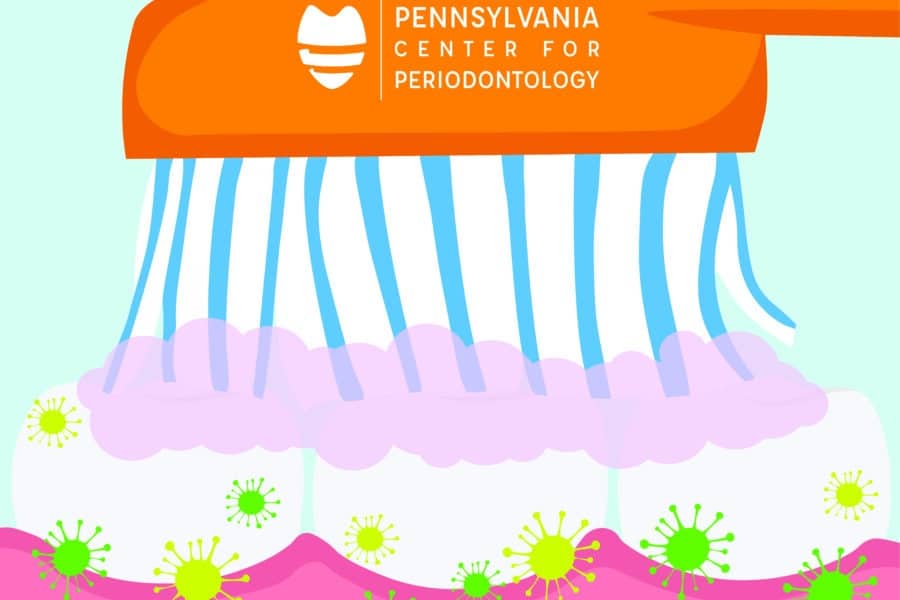Your Oral Health
While many of us visit the dentist for cleanings, why are we getting those cleanings and what does it mean if they tell us that we have gum disease? Sometimes being told that you have gum disease or what your dentist calls periodontal disease can be confusing and maybe even a bit scary.
As dental professionals, we are here to help our patients understand why cleanings are not only important to their smiles but also their overall health. We are also here to help our patients who have been diagnosed with periodontal disease understand what it is, why and how it should be treated, and how we can work together toward your improved oral health.
The Dental Cleaning
Typically, a dental cleaning is performed at your dental office every six months. Generally, that appointment has two parts, the oral examination that is completed by your dentist and the cleaning, which is called the oral prophylaxis, which is performed by your dental hygienist.
At this appointment, your dental professionals make assessments of your oral health by checking your teeth for decay and evaluating the health of your gums. Gum health is checked by measuring the space between your tooth and gums, noting the amount of buildup on your teeth and areas of gum bleeding.
Your hygienist uses special tools to remove the buildup on your teeth and under your gums using a technique called scaling, which removes soft buildup called plaque and hard buildup called calculus or tartar. After scaling, your hygienist may polish your teeth to remove surface stains.

At this appointment, if your dental team finds evidence of periodontal (gum) disease, they may explain that you need advanced care to treat it.
The Periodontal Evaluation
After diagnosing that you have some level of disease, your dentist may refer you to a specialist called a periodontist who will evaluate your gums to determine your level of periodontal disease. The periodontist will measure the space between your tooth and gum, which is called a periodontal pocket. If those spaces are deeper than normal and show signs of redness, inflammation, bleeding, or tenderness, the periodontist will diagnose your level of gum disease and discuss ways to treat it.
What is Periodontal Disease?
Periodontal disease is an infection within your gum tissue, supporting ligaments, and jawbone. This infection is caused by bacteria that is present in plaque, a soft and sticky substance on our teeth that forms daily. Without periodontal therapy, this disease can worsen and cause gum and bone loss that can lead not only to tooth loss but can also affect your overall health.
What Causes Periodontal Disease?
Although bacteria cause the periodontal infection, other health and lifestyle factors may exist that can worsen the disease progression. Those risk factors are categorized as either primary or secondary risk factors.
Primary risk factors may include genetics, health issues such as diabetes, tobacco use, and poor homecare. Secondary risk factors may include long intervals between dental cleanings, certain medications that can affect your mouth, hormonal changes, and stress.
Your teeth themselves may also be part of the problem if you have misaligned or missing teeth, grind or clench your teeth, or have obstacles to brushing like large fillings or braces.
Identifying risk factors is one of the first steps in establishing the best therapies to treat your disease.
Why is Periodontal Treatment Important?
Obviously, the mouth is not separate from the rest of the body. So, if your mouth is not healthy, it can affect your overall health. Many links exist between periodontal disease and other systemic diseases such as diabetes, heart disease, stroke, Alzheimer’s Disease, pneumonia, and even some forms of cancer. In addition, periodontal inflammation is linked to body inflammation, which is your body’s way of trying to fight the infection. Many medical conditions are linked to inflammation, of which periodontal disease can be part of the cause.
Most recently, the main comorbidities that are associated with Covid-19 complications are heart disease and diabetes, both of which are linked to periodontal disease. This new connection highlights yet another reason why maintaining health gums is vital to overall health.
How Can Periodontal Disease Be Treated?
Periodontal disease can be treated through both non-surgical (Phase 1 Therapy) and surgical (Phase 2 Therapy) treatments.
Phase 1 Therapy is usually performed by a periodontal dental hygienist. This therapy involves a procedure called Scaling and Root Planing (SRP). SRP is a non-surgical procedure, which is typically done in two appointments that involves cleaning the tooth structure underneath the gums where the infection exists. While this is not a surgical procedure, your hygienist is working in an area of active gum infection, which is why they will utilize anesthetic agents to ensure that you are comfortable throughout the appointment.
The purpose of SRP is to remove bacteria in plaque and calculus deposits that are on the roots of the teeth in deep areas that you cannot reach when you brush, and regular cleanings cannot smooth. Removing the bacteria and deposits and smoothing the roots will help to reduce active infection. This process will reduce inflammation, bleeding, and the periodontal pocket depths, all of which will help you more easily keep your teeth and gums clean at home.
A few weeks after SRP, your periodontist will re-evaluate your condition by measuring your periodontal pockets to assess improvement in active infection. Depending on your level of infection at the onset of treatment and level of post-SRP pocket reduction, your periodontist may recommend treatment, which can include Phase 2 Therapy and Periodontal Maintenance.
What is Phase 2 Therapy?
Phase 2 Therapy involves the periodontist performing surgical and laser procedures that are necessary to repair the damage to your gums and bone that was caused by the infection. Without repair, the damaged areas could be vulnerable to new bacterial growth, further damage, and risks to overall health.
Unlike past procedures, new periodontal therapies such as the use of lasers make Phase 2 minimally invasive with much less discomfort and downtime.
What is Periodontal Maintenance?
Once you have completed the recommended phases of therapy, your periodontist will recommend the best maintenance schedule for you.
Because periodontal disease is a disease that is caused by bacteria that forms in your mouth daily, the risks that cause the disease still exist and will need to be monitored and maintained through periodic visits to your periodontal office for Periodontal Maintenance. Periodontal Maintenance is an appointment with the periodontal dental hygienist in which they complete a full-mouth scaling under the gums, measure the pocket depths, evaluate your oral hygiene, and make recommendations for home care. While this is a thorough scaling under the gums, it is not SRP. To you as the patient, Periodontal Maintenance will seem much like a regular cleaning at your dental office but may take a bit more time in the chair. While no anesthesia is needed, rest assured that your periodontal hygienist will keep you comfortable throughout the procedure.
The periodontist will reexamine your periodontal condition at this appointment as well to verify that your gums remain stable and healthy.
Periodontal Maintenance becomes the recommended treatment along with the prophylaxis at your dental office because once you have had periodontal disease, you become a periodontal patient with more specific needs to maintain your oral health. While in the past, your cleanings may have been every six months, now that you have been diagnosed with and have been treated for periodontal disease, the plaque and calculus, which are the source of the harmful bacteria, must be removed more often. Six months gives the bacteria too much time to infect your gums again, which is why your periodontist may recommend a more frequent cleaning schedule that alternates between their office and your general dentist’s office. Typically, periodontal patients should visit every 3-4 months.
Home Care: How You Become Part of the Team
Keep in mind that the bacteria that causes periodontal disease forms daily within your mouth and has the potential to cause damage. Although you will be getting more cleanings for your disease, you must also become part of the team because your daily oral hygiene will determine how much bacteria is within your mouth daily.
During your initial periodontal treatment in Phase 1 Therapy, your hygienist will review oral hygiene instruction because brushing and flossing alone are often not enough to remove the bacteria. Your hygienist will help you develop a home care routine that will remove the most amount of bacteria in the most efficient and safe way for you. Recommendations may include new tools like power toothbrushes, floss, special in-between cleaning tools, antimicrobial mouth rinses, and special toothpastes that can all help to reduce the harmful bacteria every day.
Working together, we can help you achieve better oral health, which is vital to overall health.
